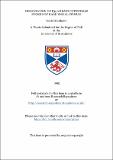Files in this item
Dissociation of P300 brain potentials evoked by rare visual stimuli
Item metadata
| dc.contributor.advisor | Rugg, M. D. (Michael D.) | |
| dc.contributor.author | Matthews, David | |
| dc.coverage.spatial | 364 p., 1 p. of plates. | en_US |
| dc.date.accessioned | 2018-06-29T08:38:36Z | |
| dc.date.available | 2018-06-29T08:38:36Z | |
| dc.date.issued | 1995 | |
| dc.identifier.uri | https://hdl.handle.net/10023/14732 | |
| dc.description.abstract | The P300 event related potential (ERP) has consistently been dissociated into separate components on the basis of scalp amplitude distribution within the auditory modality (for instance Squires et al. 1975). A parietally maximum P300 deflection being evoked in response to target stimuli in comparison with a more frontally maximum P300 deflection evoked in response to rare nontarget stimuli. Results obtained within experiment 1 and 6 demonstrated such a dissociation employing auditory stimuli within a three stimulus oddball paradigm. It did not prove possible to obtain such a dissociation of P300 deflections on the basis of scalp amplitude distribution within the visual modality. Across a number of experimental manipulations both target and rare nontarget stimuli evoked P300 deflections with similar amplitude distributions (centro-parietal maximum along the midline). Experiment 5 demonstrated that frequent stimuli similarly evoked a centro-parietal maximum amplitude distribution. It was demonstrated that both stimulus probability (Experiment 4) and the physical characteristics of the stimuli (Experiment 5) affected the mean amplitude of the evoked P300 deflection. However, the scalp amplitude distribution of the evoked deflections remained constant. Within Experiment 6 it was demonstrated that within both auditory and visual modalities P300 deflections, evoked in response to both target and rare nontarget stimuli, demonstrated an equipotential amplitude distribution within an elderly group of subjects. In addition across both modalities amplitude evoked in response to rare nontarget stimuli demonstrated an asymmetric distribution across lateral chains of electrodes. Amplitude evoked along the right chain was significantly reduced in comparison to that evoked along the left chain. It would appear that the same, or a similar combination of, underlying neural generators are responsible for the activity that may be recorded at the scalp as the P300 deflection within the visual modality. | en_US |
| dc.language.iso | en | en_US |
| dc.publisher | University of St Andrews | |
| dc.subject.lcc | QP379.M2 | |
| dc.subject.lcsh | Cerebellum | en |
| dc.title | Dissociation of P300 brain potentials evoked by rare visual stimuli | en_US |
| dc.type | Thesis | en_US |
| dc.type.qualificationlevel | Doctoral | en_US |
| dc.type.qualificationname | PhD Doctor of Philosophy | en_US |
| dc.publisher.institution | The University of St Andrews | en_US |
This item appears in the following Collection(s)
Items in the St Andrews Research Repository are protected by copyright, with all rights reserved, unless otherwise indicated.

